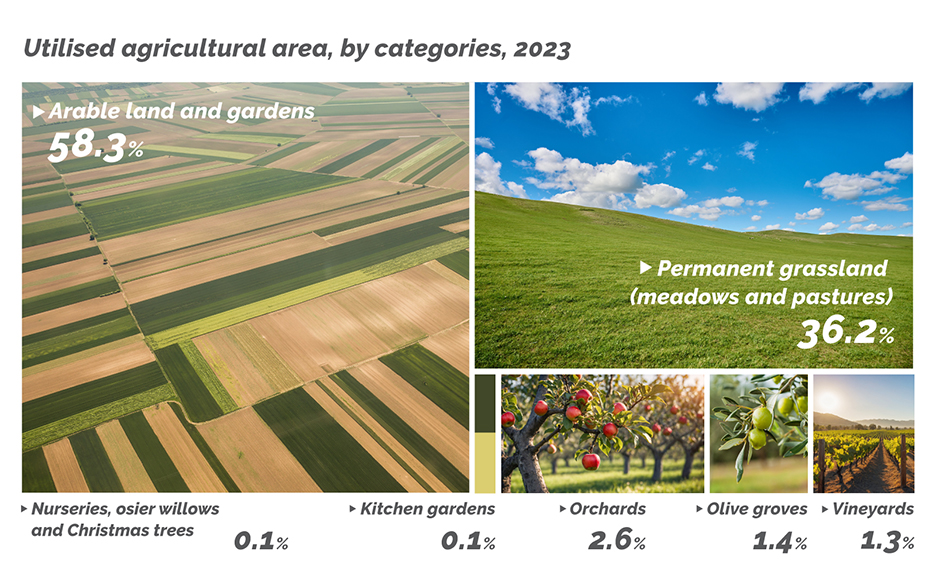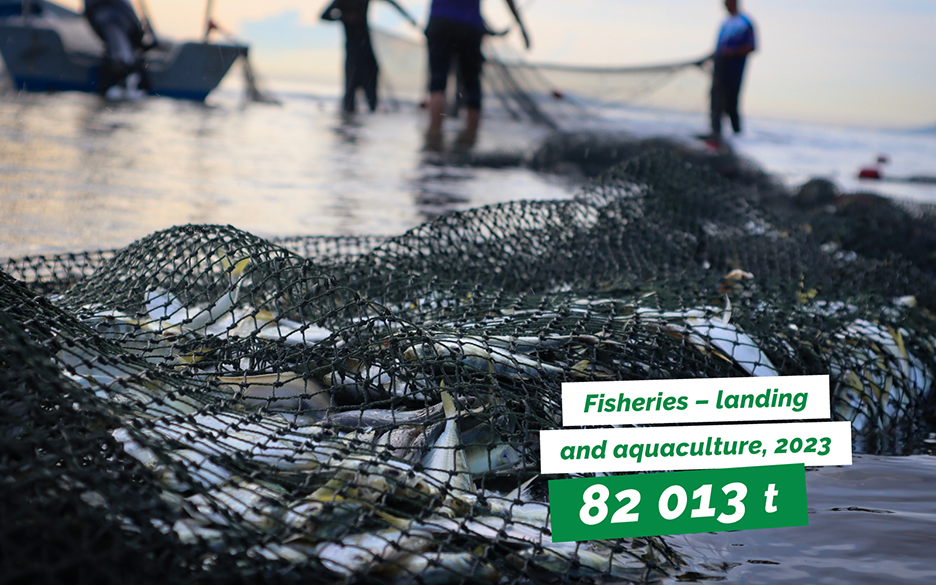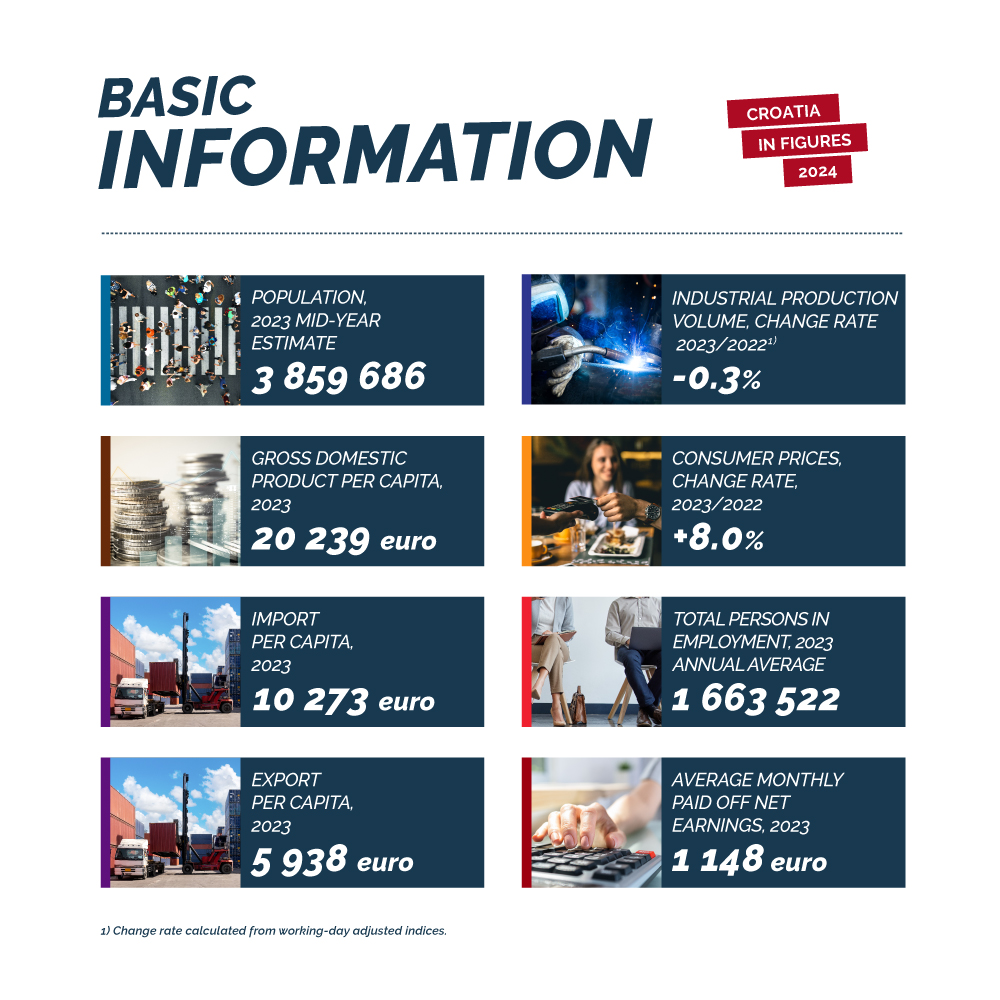| * |
corrected data |
| - |
no occurrence |
| ... |
data not available |
| . |
not zero, but not published due to the extremely inaccurate estimation |
| p |
less accurate estimation |
| ( ) |
less accurate data |
| bn |
billion |
| CEFTA |
Central European Free Trade Agreement |
| CHP |
combined heat and power generation |
| DWT |
deadweight tonne |
| ECOICOP |
Classification of Individual Consumption according to Purpose |
| EU |
European Union |
| EUR |
euro |
| GDP |
gross domestic product |
| GT |
gross tonnage (gross registered tonnage) |
| GWh |
gigawatt hour |
| ha |
hectare |
| km |
kilometre |
| km2 |
square kilometre |
| kW |
kilowatt |
m2 |
square metre |
| m3 |
cubic metre |
| MIGs 2009 |
Main Industrial Groupings 2009 |
| mln |
million |
| NIP |
Nomenclature of Industrial Products |
| NKD 2007 |
National Classification of Activities, 2007 version |
| NN |
Narodne novine, official gazette of the Republic of Croatia |
| NPISH |
non-profit institutions serving households |
| PIN (OIB) |
personal identification number |
| t |
tonne |
| '000 |
thousand |
| VAT |
value added tax |
Published by the Croatian Bureau of Statistics, Zagreb, Ilica 3, P. O. B. 80
Phone: (+385 1) 48 06 111
Web site: dzs.gov.hr
Press corner: press@dzs.hr
Persons responsible:
Andrea Galić Nagyszombaty, Director of Statistical Methodologies, Quality and Customer Relations Directorate
Mario Vlajčević, Director of Demographic and Social Statistics Directorate
Suzana Šamec, Director of Macroeconomic Statistics Directorate
Edita Omerzo, Director of Spatial Statistics Directorate
Milenka Primorac Čačić, Director of Business Statistics Directorate
Lidija Brković, Director General
Prepared by: Kristijan Jurić, Maja Marković and Ana Samaržija
Editor: Ljiljana Ostroški
Technical Editor: Ankica Bajzek Cesar
Language Editor: Maja Gregorić
Translator: Neda Batinić
Graphic Design: Sanja Huseinagić and Nino Mrša
ISSN 3044-1692
USERS ARE KINDLY REQUESTED TO STATE THE SOURCE WHEN USING THE DATA
Agriculture is most certainly one of the pillars of the economy, and monitoring the production, prices and sales gives an insight into the state of agriculture, available resources, needs of the market and the opportunities for improving the sector that is immensely important for every country. Independent food production is a great advantage, and agriculture statistics contribute to planning and adopting appropriate measures.
If we consider agriculture as the bloodstream of a country, then the production of wheat is often called its lifeblood. It is worth pointing out that the production of wheat decreased by 13.3% in 2023, as compared to 2022. On the other hand, the production of grain maize increased by 21.3% in 2023, as compared to the previous year.
Livestock production is a vital element in this agricultural “organism“. In 2023, as compared to previous years, the number of livestock and poultry maintained a downward trend. Compared to 2022, the total number of cattle decreased by 1.7%, pigs by 9.7%, sheep by 14.2% and poultry by 1.6%.
Available agricultural land is the basis for all agricultural activities. More than half of the agricultural land in 2023 was arable land, while more than a third were permanent grasslands.

The goal of every farmer, whether from a small private family farm or a large agricultural holding, is to place products on the market. The value of purchase and sale of agricultural products in 2023 amounted to 1 450.8 million euro, and out of that the value of sale from own production amounted to 916.6 million euro or 63.2%, while the value of purchase amounted to 534.2 million euro or 36.8%. Compared to 2022, the purchase and sale value of agricultural products decreased by 8.4%, out of which the value of sale from own production of business entities remained the same, whereas the value of purchase from private family farms decreased by 19.9%.
In addition to this, there are other "economic" indicators within agricultural statistics. The value of agricultural production in 2023 amounted to 2 840 million euro, which was a decrease of 12.5% compared to the previous year. The gross value added in 2023 amounted to 1 395 million euro, which was a decrease of 18.8% compared to the previous year.
When talking about the statistics of this large sector, it should be emphasized that it also includes data from the fields of forestry and fisheries, both of which represent Croatia's great wealth and advantage. Therefore, it is pleasing that the total area of forest land remained at approximately the same level in 2023, as compared to previous years.

There could never be enough talk about the importance of preserving forests and their resources, but for this presentation, we provide the latest data on commercial timber production. Namely, despite the decrease of total logging by 2.7% in 2023, as compared to the previous year, the average logging trend has been maintained over the past few years. At the same time, the production of fuel wood decreased by 1.0%, the production of industrial roundwood (wood in the rough) decreased by 4.3% and the production of logs by 1.7%, as compared to 2022.
Fisheries and aquaculture
As for marine fisheries, in 2023 compared to 2022, the landing of small pelagic fish decreased by 13.0%, which is a result of the implementation of management measures aimed at achieving the sustainability of fishing resources, especially small pelagic fish, at the level of the European Union and the Republic of Croatia, as well as climate change and bad weather conditions during fishing periods.
It should also be noted that the largest quantities of landings in the Republic of Croatia are achieved by purse seine nets that catch small pelagic fish (sardines and anchovies), with a share of 88.7% of the total landing in 2023, and bottom trawl nets with a share of 6.7%.1)
Marine and freshwater aquaculture are often highlighted as having great potential, primarily due to their importance in healthy nutrition and the fact that the human population is growing worldwide, and sustainable management of fishing resources requires restrictive measures and a reduction in landings. In addition, we are also witnessing the negative consequences of climate change, which also contribute to the reduction of landings.
Marine aquaculture in the Republic of Croatia accounts for more than 86.3% of the total farming, with sea bass and sea bream (white fish), Atlantic bluefin tuna (blue fish) and mussels and oysters (shellfish) being the dominant species, while carp and rainbow trout predominate in freshwater farming.

1) Source: Ministry of Agriculture, Forestry and Fisheries – Directorate of Fisheries
← Previous Next →
 Hrvatski
Download data
Hrvatski
Download data




